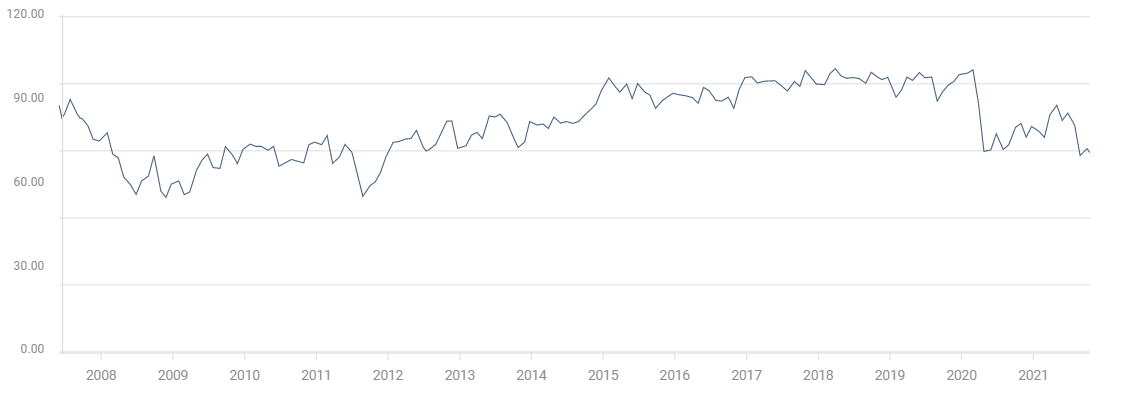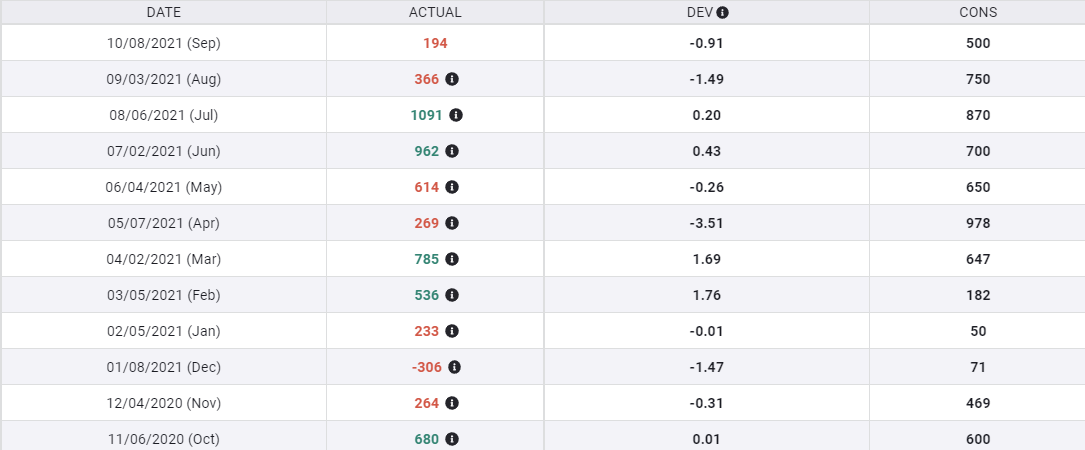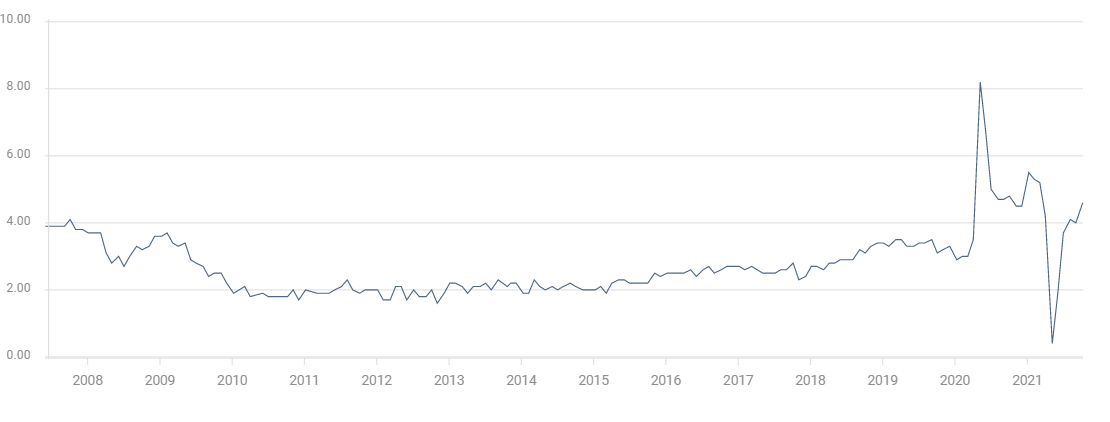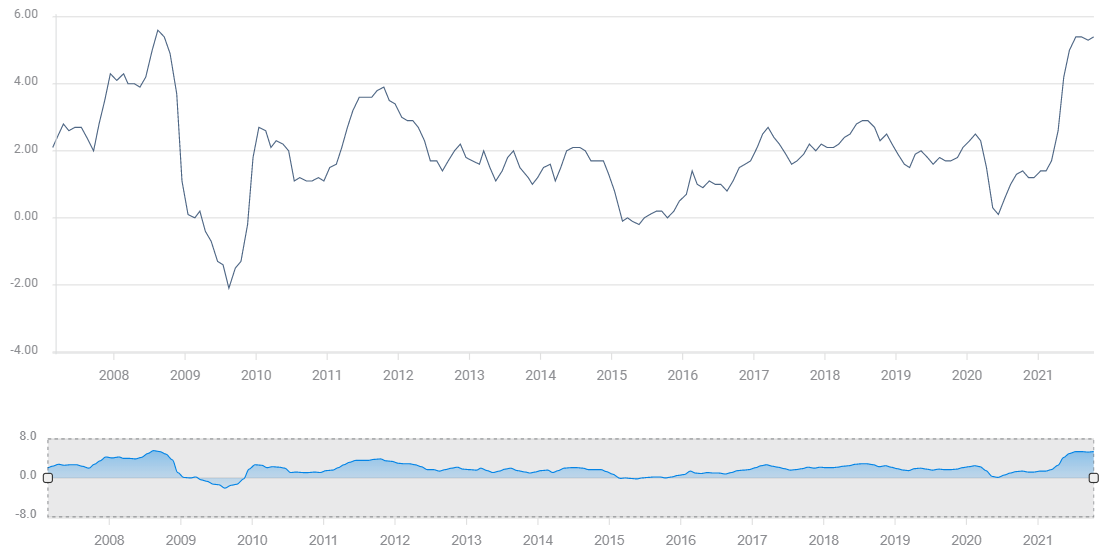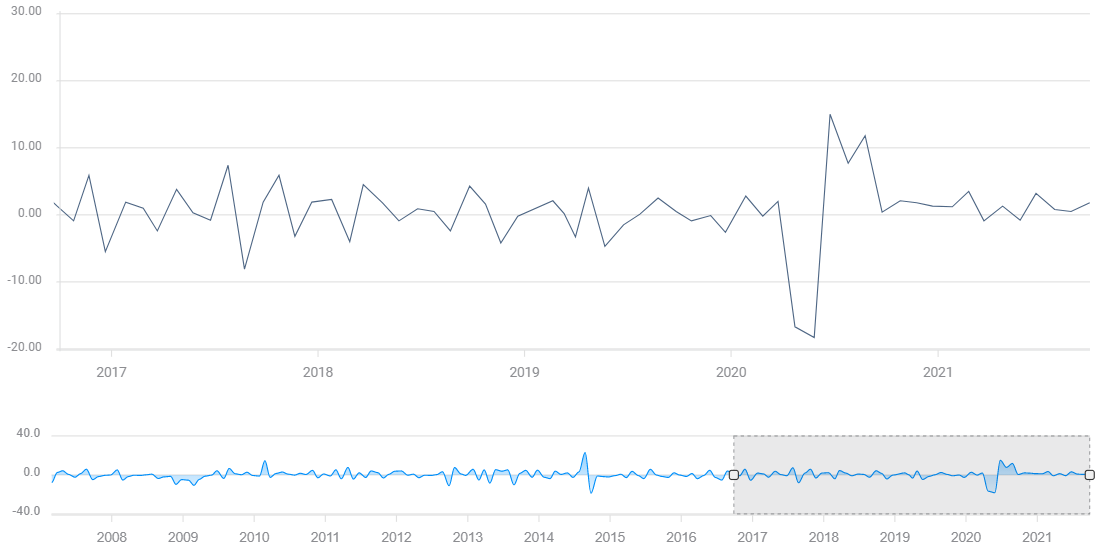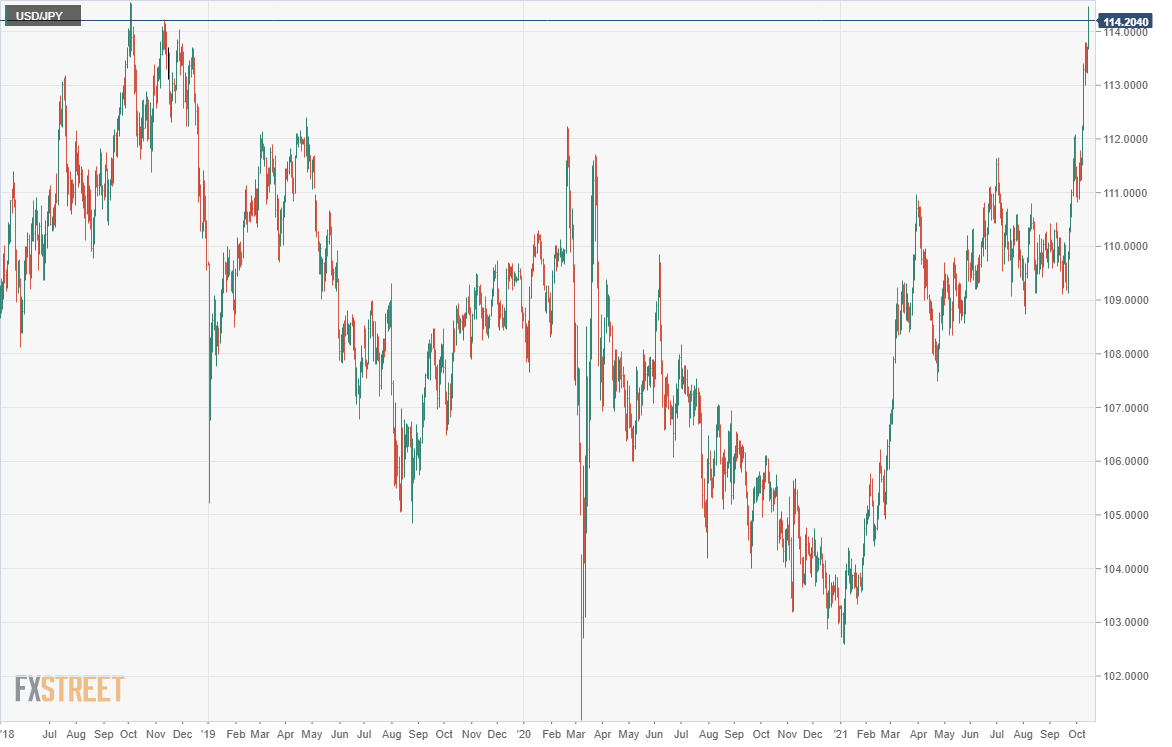- Consumer Sentiment falls in October to 71.4, just above a decade low.
- Retail Sales in September wallop expectations for the second month in a row.
- Labor market is not the source of consumer discontent.
- Markets focus on Retail Sales not Consumer Sentiment.
For three months American consumers have told surveys they are unhappy. Not just mildly upset but suffering an attack of pessimism not seen in a decade.
In August, seemingly out of the blue, the Michigan Consumer Sentiment Index plunged to 70.3 from 81.2. For the previous five months consumer outlook had plateaued about 10 points above the pandemic low of 71.8 from April 2020. In September sentiment rose slightly to 72.8. In October it fell back to 71.4.
Michigan Consumer Sentiment Index
FXStreet
Except for the pandemic collapse in the spring of last year of almost 30 points in two months, the August drop was the largest one-month decline since October 2008 at the height of the financial crisis.
The last time the Michigan Index was as low as August was December 2011. The October score is below the pandemic bottom in April 2020.
Are US economic conditions that dismal?
Labor market
Whatever was annoying consumers in August, it wasn’t the labor market.
Nonfarm Payroll hiring in June and July averaged over one million new positions each month. Job creation was the strongest since 7.7 million people were re-employed in May and June last year in the initial recovery from the lockdown debacle.
August’s slowdown to 366,000 looks bad in comparison to the 750,000 expected by economists. In reality, it isn't that far from the 517,500 average of the prior 12 months. A one month drop in job creation does not equate to a decade low in consumer outlook.
Nonfarm Payrolls
FXStreet
Hiring fell in August and September but it was not because the economy didn’t have employment.
The Job Openings and Labor Turnover Survey (JOLTS) reported 10.4 million open positions in August, down slightly from the all time record of 11.1 million in July.
JOLTS
FXStreet
Employers were desperate for help. Hiring fell because people did not seek the jobs on offer.
Worker diffidence has been blamed on the continuing pandemic, vaccination mandates, extended unemployment benefits and a preference for flexible homework which may not register in official statistics.
Wages
The JOLTS data set successive records for the greatest numbers of open jobs for five straight months from March through July.
Labor shortages have prevented many businesses from operating efficiently or at full capacity, despite strong demand. One remedy, tried by many firms across the country, is higher wages and bonuses.
Annual Average Hourly Earnings have more than doubled in five months, from 1.9% in May to 4.6% in September. These increases are not the result of a statistical recovery based on a collapse in wages a year earlier. If anything the May to September 2021 data understates the increases since the average monthly gain in those months in 2020 was 5.2%.
Average Hourly Earnings
FXStreet
Employers are paying more because they must. Employees are the beneficiaries. That is why 4.3 million people quit their jobs in August, a record, with the greatest number in accommodation and food service, according to the Bureau of Labor Statistics. Workers don’t leave employment in such numbers unless they are certain of finding new, and likely, better paying jobs.
Inflation
Consumers dislike inflation. Rising prices are a direct and immediate tax on income. Wages increase only at long intervals, household expenses can climb every shopping trip.
The current bout of rising prices is just six months old. In March the annual Consumer Price Index (CPI) was 2.6%. Even though by September CPI had more than doubled to 5.4%, expectations for long-term inflation have remained subdued.
Consumers no doubt hate paying 50% more for gas, but that is probably not enough to change their whole economic outlook.
CPI
FXStreet
Retail Sales and Durable Goods
Were consumers truly worried about the future, their retail behavior should reflect that concern. Households might be expected to promote savings over spending, restrict discretionary purchases and forgo large expenditures.
This has not happened.
Retail sales rose 0.9% in August and 0.7% in September, belying the dour predictions for declines of 0.8% and 0.2% respectively.
Purchases of Durable Goods, long-lasting big ticket items, rose 1.8% in August, more than twice the 0.7% forecast and three times the 0.5% July increase.
Americans have not been deterred from large financial commitments. The September goods figures will be released on October 27.
Durable Goods
Market response
Markets focused on the consumption facts in the September Retail Sales figures rather than the sentiment numbers in the Michigan Survey.
Equities had a field day with the Dow adding 382.20 points, 1.09% to 35,294.76. The S&P 500 rose 0.75%, 33.11 points to 4.471.37.
Treasury yields rose in all durations with the 10-year picking up 5.5 basis points to 1.574% and the 30-year climbing 2 points to 2.046%. The benchmark 10-year closed on the week off 4 points from its 1.612% open on Tuesday and is still 17 points below its 2021 high of 1.746% on March 31.
US Treasury yields
CNBC
The dollar was slightly lower on the day in all the major pairs except the yen where it closed above 114.00 for the first time in three years.
Conclusion
Consumer sentiment, normally a reliable indicator to consumer spending, seems to have lost its guidance.
The disconnect is striking. Americans are unhappy. Sentiment has plumbed a decade low for three straight months.
Naturally enough analysts took those feelings and extrapolated a reflective decline in consumer behavior, that is, a substantial decline in retail sales. Economic logic argues that if consumers are worried they should begin to pull back on consumption in preparation for difficult conditions ahead.
This did not happen. Retail Sales were far worse in July at -1.1%, with a much higher sentiment index, than in August and September. When consumer outlook plunged, sales rebounded.
Consumer sentiment was designed and has always been seen as an economic measurement. When viewed against a stable political and cultural background that has been accurate.
The current American scene is far from stable. By most measures political and cultural polarization is at an all-time high. Many Americans seem to have moved from disagreement with their neighbors to active dislike and even distrust.
Perhaps the Michigan Index is registering unhappiness with something other than the economy.
Have these unexpressed emotions begun to seep over into polls of economic welfare? By most objective measures the economy is quite good for workers.
The next few months will tell if the separation between economic sentiment and reality is speculative or permanent.
One thing is certain, there is no shortage of unnerving developments in the United States or the world. A glance at the headlines suffices.
Information on these pages contains forward-looking statements that involve risks and uncertainties. Markets and instruments profiled on this page are for informational purposes only and should not in any way come across as a recommendation to buy or sell in these assets. You should do your own thorough research before making any investment decisions. FXStreet does not in any way guarantee that this information is free from mistakes, errors, or material misstatements. It also does not guarantee that this information is of a timely nature. Investing in Open Markets involves a great deal of risk, including the loss of all or a portion of your investment, as well as emotional distress. All risks, losses and costs associated with investing, including total loss of principal, are your responsibility. The views and opinions expressed in this article are those of the authors and do not necessarily reflect the official policy or position of FXStreet nor its advertisers. The author will not be held responsible for information that is found at the end of links posted on this page.
If not otherwise explicitly mentioned in the body of the article, at the time of writing, the author has no position in any stock mentioned in this article and no business relationship with any company mentioned. The author has not received compensation for writing this article, other than from FXStreet.
FXStreet and the author do not provide personalized recommendations. The author makes no representations as to the accuracy, completeness, or suitability of this information. FXStreet and the author will not be liable for any errors, omissions or any losses, injuries or damages arising from this information and its display or use. Errors and omissions excepted.
The author and FXStreet are not registered investment advisors and nothing in this article is intended to be investment advice.
Recommended Content
Editors’ Picks
AUD/USD stands firm above 0.6500 with markets bracing for Aussie PPI, US inflation

The Aussie Dollar begins Friday’s Asian session on the right foot against the Greenback after posting gains of 0.33% on Thursday. The AUD/USD advance was sponsored by a United States report showing the economy is growing below estimates while inflation picked up. The pair traded at 0.6518.
EUR/USD faces a minor resistance near at 1.0750

EUR/USD quickly left behind Wednesday’s small downtick and resumed its uptrend north of 1.0700 the figure, always on the back of the persistent sell-off in the US Dollar ahead of key PCE data on Friday.
Gold soars as US economic woes and inflation fears grip investors

Gold prices advanced modestly during Thursday’s North American session, gaining more than 0.5% following the release of crucial economic data from the United States. GDP figures for the first quarter of 2024 missed estimates, increasing speculation that the US Fed could lower borrowing costs.
Bitcoin price continues to get rejected from $65K resistance as SEC delays decision on spot BTC ETF options

Bitcoin (BTC) price has markets in disarray, provoking a broader market crash as it slumped to the $62,000 range on Thursday. Meanwhile, reverberations from spot BTC exchange-traded funds (ETFs) continue to influence the market.
US economy: Slower growth with stronger inflation

The dollar strengthened, and stocks fell after statistical data from the US. The focus was on the preliminary estimate of GDP for the first quarter. Annualised quarterly growth came in at just 1.6%, down from the 2.5% and 3.4% previously forecast.
